Sayur lemak, which literally means “fat vegetables”, is sort of like curry. It’s not a thick, hearty curry like you might typically envision curry to be; it’s rich, yet refreshing because of the coconut milk and kaffir lime leaf. I think “sayur lodeh” is another name for sayur lemak, as they both have similar recipe results when I search them up. “Sayur lemak” is how I’ve grown up knowing it.
Click here to jump to the recipe.
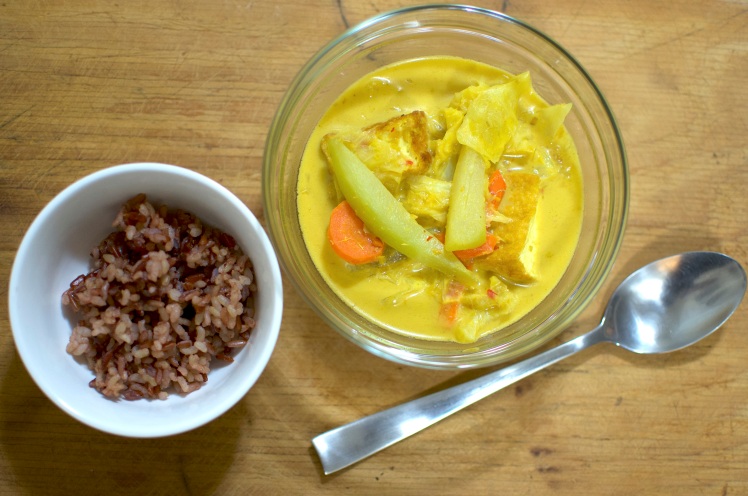
When I was small, our family knew a caretaker/maid who made an excellent sayur lemak. For years afterwards, my mother would talk about her sayur lemak and encourage me to try to learn it from her. Unfortunately I never got the chance to, but I often think about how insistent my mother was about learning that sayur lemak recipe. I decided to adapt a version for myself to eat.
My edition of sayur lemak is far from any traditional Malaysian version, and lacks some of the essential ingredients that go in. I haven’t found candlenuts in my asian markets, and I don’t cook with onions or garlic, so I’ve omitted those ingredients. Asafoetida does a little bit to account for onion/garlic.

Ingredients for the curry paste: lemongrass, small Thai chili, ginger, galangal, turmeric powder (you can use fresh turmeric but I didn’t have any), asafoetida, sweet wheat paste (“tian mian jiang”), and hot broad bean paste (“dou ban jiang”). You can leave out the sweet wheat paste if you want.
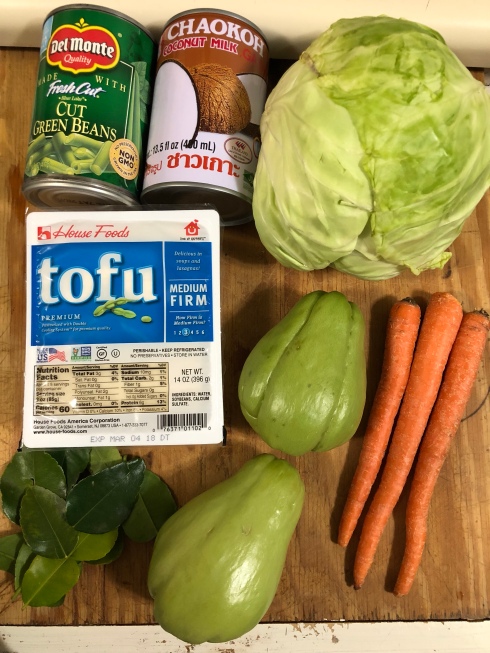
Curry ingredients: fresh beans (I didn’t end up adding beans this time because they were already cooked and mushy in the can…my mistake not to have fresh), coconut milk, cabbage, chayote, carrot, tofu, and kaffir lime leaves.
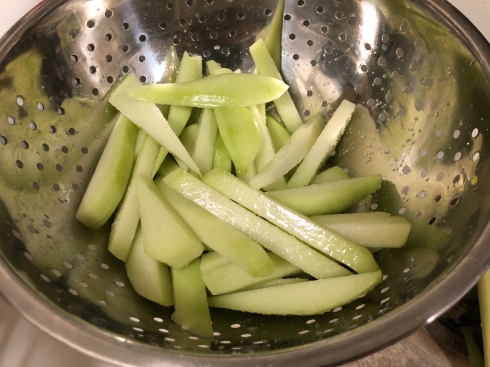
First cut the chayote into strips, avoiding the seed in the middle, and then wash them and cover them in salt. This gets rid of the sliminess. You can wear rubber gloves when handling chayote, because their slimy stuff coats hands and can dry skin out. Set the salted chayote strips aside while you do everything else.

Peel the ginger, galangal and outer layer of the lemongrass. Cut them all up into manageable chunks and dump them in a food processor or blender. I like to de-seed the chilis, since I have low spicy food tolerance.

They don’t get blended smoothly in a food processor, so if you want a less gritty curry, use a blender. If you’re using a blender, you’ll most likely need to add 2-3 tablespoons of oil. I also put about that much into my food processor and later put the paste straight into a hot stainless-steel pot without adding oil.
 Mm, curry paste.
Mm, curry paste.

Chop the vegetables. Carrots are usually cut matchstick style, but you can really cut them any way you want. Just remember you’d need to adjust cooking time accordingly if you don’t do it this way.

Roughly chop cabbage and wash it.
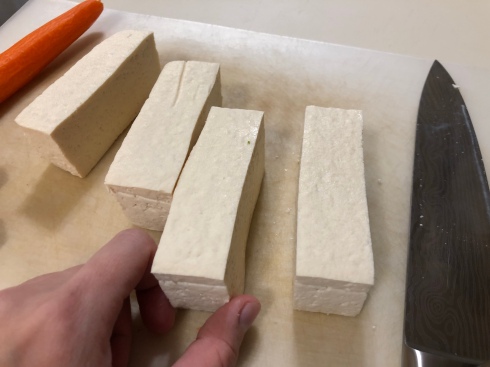
You can skip this step if you have store-bought fried tofu, but I didn’t. I deep-fried my own. It’s much tastier this way.
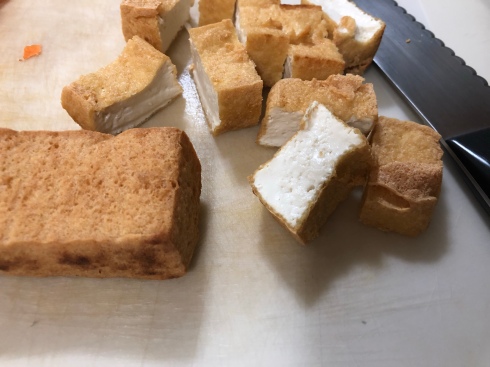
Let’s make the curry! I forgot to take a picture of the curry paste being cooked. Just heat up a big pot over medium heat, throw it all in, and stir it around for a couple of minutes until it softens a bit and becomes even more fragrant. Then pour in the stock and coconut milk. I usually like to use coconut cream instead, as it’s even more rich and delicious.

Put the kaffir lime leaves in and bring it to a boil. Rinse the chayote with fresh water. Then throw the cabbage and chayote into the soup, stir it up, and let it simmer covered for 4 minutes.
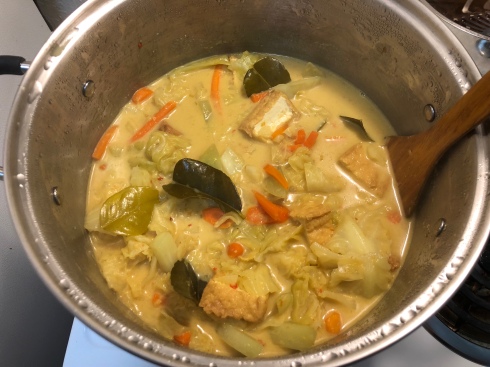
Put the rest of the vegetables in, cover them with the soup, put the lid on the pot and let it simmer for another 4-6 minutes depending on how tender you like your veges. I like mine quite tender. Add salt to taste.
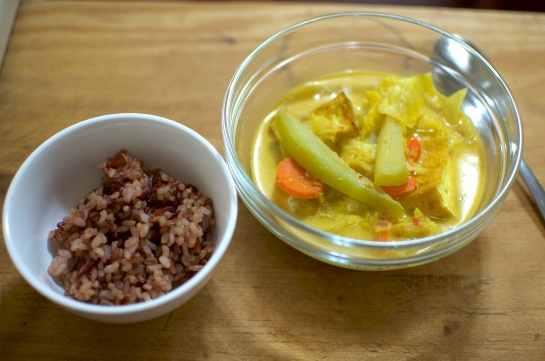
Serve with rice!
Sayur Lemak
Ingredients
For the curry paste:- 3-4 small red Thai chilis
- 1/2 tsp asafoetida
- 1/2 tsp turmeric powder
- 35g (2 inches) ginger
- 35g (2 inches) galangal
- 1 Tbs spicy broad bean paste (“dou ban jiang”)
- 1 Tbs sweet wheat paste (“tian mian jiang”)
- 2 fresh lemongrass (or 1 Tbs lemongrass powder)
- 3 Tbs vegetable/coconut oil
For the curry:
- 1 carrot
- 1 cup green beans
- 1/2 cabbage
- 1 chayote
- (optional) 1 zucchini
- 400g fried tofu (or 400g/14oz block of medium firm tofu)
- 400ml coconut milk
- 500ml vegetable stock
- 3 kaffir lime leaves
Directions
To make the curry paste:- If using fresh lemongrass, cut off the very bottom (hard part) of the stalk and discard the green tops. Chop coarsely. Peel the galangal and cut into small chunks (for easy blending), removing the hard bits of root. Peel the ginger and cut into small chunks. Cut the green tops off of the chilis, cut them in half and deseed them if you want the curry less spicy.
- Blend everything in a blender or food processor with 2-3 Tbs of vegetable oil or coconut oil.
To make the curry:
- (Optional) If you don’t have deep fried tofu and want to make your own, cut the 14 oz block of tofu into 4 rectangular strips parallel to its short edge. Deep fry in oil at 180°C/356°F for 1 minute, turning the strips at least once. Take out and cut into smaller cubes.
- Heat a large soup pot over medium heat. Add the curry paste and fry until it darkens slightly and becomes fragrant.
- Add the stock, coconut milk and kaffir lime leaves. Stir and bring it to a boil.
- Add the cabbage and chayote, and simmer while covered for 4-5 minutes.
- Finally add the carrot, tofu, beans, and zucchini. Continue to simmer covered for another 4-6 minutes or until tender. Add salt to taste.
- Serve with rice.
Yum! I like to add a little balsamic vinegar or assam jawa, gives a little zing and body to the flavour. 🙂
LikeLiked by 1 person